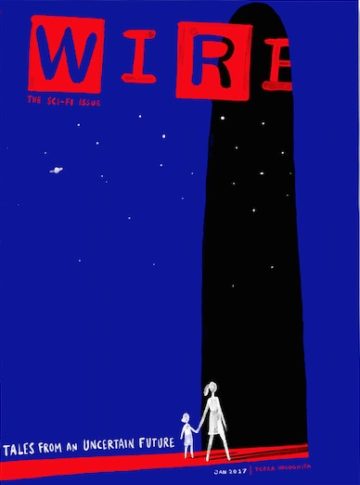This year has seen WIRED (the print and online publications) become increasingly more literary, starting with the impressive WIRED Book Club in April and now turning the January 2017 issue into the inaugural Fiction Issue. As Editor-in-Chief Scott Dadich explained in his monthly editor’s letter, “One of this publication’s most important jobs is to see the big trends, spot important business models, and chronicle landmark innovations that show us where we’re going. But right now, that is hard to do.” Instead, they decided to “consider things a little more obliquely” and invited over a dozen writers to let their minds wander, to dream as a way of approaching reality. And because their minds were wandering toward the future, WIRED decided to make the first fiction issue the first science fiction issue as well.
The result is 14 stories from N.K. Jemisin, Charlie Jane Anders, James S.A. Corey, John Rogers, and others. Each was instructed to “pick a plausible innovation or change in the world and spin out a near-term scenario,” the results of which are engrossing and distressing in equal measure.
Dadich references this as he describes some of the tales woven in this issue:
That’s not to say the stories themselves are all about fun. Many are quite dystopic. N. K. Jemisin—whose novel The Fifth Season won the 2016 Hugo award—spins a cautionary tale about resource depletion and interplanetary relations. The duo that goes by the pen name James S. A. Corey, creators of The Expanse, imagines a world with a universal basic income—and what we are left wanting. Charles Yu, who writes for HBO’s Westworld, examines what life will be like when machines can read our thoughts. Etgar Keret, the celebrated Israeli fiction author, writes about … well, just read it. And in his refreshing “review,” Glen David Gold, the author of Carter Beats the Devil, shows us what we will have to endure in the movie theater someday in the future.
The Fiction Issue is a treat to read, especially when you consider the stories in context with one another.
Charlie Jane Anders’ “Stochastic Fancy: Play the Game and Find True Love” achieves what my favorite speculative fiction does: It marries two disparate concepts in a seamless way that makes the resulting combination seem much more plausible than either one on its own. As our lonely—or is it lonesome?—narrator answers infinite mindless polls resembling online dating website questionnaires on their KloudsKape implant, they catch the eye of a handsome gent in the same café, answering the same questions. Are they compatible? To make a potential love connection, our (definitely lonesome) protagonist must answer the really tough questions. As this short but compelling tale goes on, they toss out vital data so thoughtlessly that it made me shudder—and then I realized that I’ve been guilty of the same, from filling out the OkCupid questionnaire that eventually led me to my partner to dutifully filling out Twitter polls from my personal and professional peers. It’s the kind of science fiction that doesn’t feel so fictional.
In fact, implants are a recurring theme in a number of the pieces: The bouncing ball in the KloudsKape is not unlike the increasingly aggressive subconscious speaking to you through SubText®, the latest tech-sphere innovation in Charles Yu’s “SubText®: It Knows What You’re Thinking Stop Thinking.” And in turn, the ways in which SubText® begin creating self-fulfilling prophecies in its increasingly-inward-thinking users brings to mind (heh) the double-edged sword of the Lifebrarian in Malka Older’s “The Black Box: These Memories Are Made to Last Forever.” This story shares a premise with the Black Mirror episode “The Entire History of You” (that is, a device that records your every memory), but in this case it brings the dilemmas of the usefulness of drowning in your own nostalgia and protagonist Sumi’s efforts to be the kind of upstanding citizen she wants her memories to reflect, if and when family and strangers someday riffle through them.
I loved seeing several authors approach the notion of implants from different angles yet arrive at many of the same themes. It’s what I envision as the most likely bit of “sci-fi” tech to enter into our culture, perhaps even within my own lifetime; the baby steps are there, with the rise of the biopunk and biohacking communities. I’d be interested to see WIRED repeat this experiment looking ahead to 2018 and see what tech or other sci-fi concept is on everyone’s minds by then.
While N.K. Jemisin’s “The Evaluators: To Trade with Aliens, You Must Adapt” stands apart from the other stories in subject matter, it’s still thematically linked: The account of a First Contact team’s disappearance with a highly advanced sapient alien race, the cheetah-resembling Manka, is told entirely through internal message-board postings, external blog posts, and recovered auditory streams of human/Manka meetings. All optimized by CogNet! the story is quick to remind you. In fact—that proves my point, cognitive implants are king. Like Arrival, this piece depicts the cultural misunderstandings that occur in human/alien exchanges, but the ominous undercurrent makes it gripping in an entirely different way.
The design of these stories is top-notch, and the commissioned illustrations are gorgeous. Delve into The Fiction Issue and let us know which stories are your favorites.










